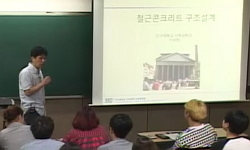Post-earthquake fire (PEF) can lead to a rapid collapse of buildings that have been partially damaged as a result of a prior earthquake. Almost all standards and codes for the design of structures against earthquake ignore the risk of PEF, and thus bu...
http://chineseinput.net/에서 pinyin(병음)방식으로 중국어를 변환할 수 있습니다.
변환된 중국어를 복사하여 사용하시면 됩니다.
- 中文 을 입력하시려면 zhongwen을 입력하시고 space를누르시면됩니다.
- 北京 을 입력하시려면 beijing을 입력하시고 space를 누르시면 됩니다.



Investigating the Effect of Prior Damage on the Post-earthquake Fire Resistance of Reinforced Concrete Portal Frames
한글로보기https://www.riss.kr/link?id=A106210627
- 저자
- 발행기관
- 학술지명
- 권호사항
-
발행연도
2012
-
작성언어
English
- 주제어
-
등재정보
SCIE,SCOPUS,KCI등재
-
자료형태
학술저널
-
수록면
209-220(12쪽)
- 제공처
-
0
상세조회 -
0
다운로드
부가정보
다국어 초록 (Multilingual Abstract)
Post-earthquake fire (PEF) can lead to a rapid collapse of buildings that have been partially damaged as a result of a prior earthquake. Almost all standards and codes for the design of structures against earthquake ignore the risk of PEF, and thus buildings designed using those codes could be too weak when subjected to a fire after an earthquake. An investigation based on sequential analysis inspired by FEMA356 is performed here on the immediate occupancy (IO), life safety (LS) and collapse prevention (CP) performance levels of two portal frames, after they are pushed to arrive at a certain level of displacement corresponding to the mentioned performance level. This investigation is followed by a fire analysis of the damaged frames, examining the time taken for the damaged frames to collapse. As a point of reference, a fire analysis is also performed for undamaged frames and before the occurrence of earthquake. The results indicate that while there is minor difference between the fire resistances of the fire-alone situation and the frames pushed to the IO level of performance, a notable difference is observed between the fire-alone analysis and the frames pushed to arrive at LS and CP levels of performance and exposed to PEF. The results also show that exposing only the beams to fire results in a higher decline of the fire resistance, compared to exposing only the columns to fire. Furthermore, the results show that the frames pushed to arrive at LS and CP levels of performance collapse in a global collapse mode laterally, whereas at the IO level of performance and fire-alone situation, the collapse mechanism is mostly local through the collapse of beams. Whilst the investigation is conducted for a certain class of portal frames, the results confirm the need for the incorporation of PEF into the process of analysis and design, and provide some quantitative measures on the level of associated effects.
동일학술지(권/호) 다른 논문
-
- 한국콘크리트학회
- Hamid Reza Ronagh
- 2012
- SCIE,SCOPUS,KCI등재
-
Evaluation of Models for Estimating Shrinkage Stress in Patch Repair System
- 한국콘크리트학회
- Stefanus A. Kristiawan
- 2012
- SCIE,SCOPUS,KCI등재
-
Study on the Fluidity and Strength Properties of High Performance Concrete Utilizing Crushed Sand
- 한국콘크리트학회
- Sangjun Park
- 2012
- SCIE,SCOPUS,KCI등재
-
Mix Design for Pervious Recycled Aggregate Concrete
- 한국콘크리트학회
- Rasiah Sriravindrarajah
- 2012
- SCIE,SCOPUS,KCI등재




 ScienceON
ScienceON





